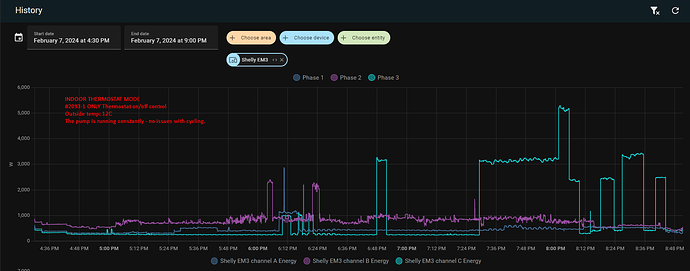Hi Michal,
It cannot run at 2kw heat output in pure water law mode because it is not efficient.
Pure water law is an efficiency mode, it runs at a set flow temperature for as long as it can.
This is what it is meant to do, it is what my heat pump does.
If your minimum electricity input is 700w and you want a COP of 5.0 then you need 3,500w of heat.
Giving 2,000w of heat won’t achieve that and that is why it doesn’t do it, it is not a room temperature control, it is control over water flow temperature.
If it can go as low as 2kw of heat output then the electrical input would need to be 400w to achieve a COP of 5.0, it’s clearly not capable of going this low in terms of electrical input.
When the heat pump stops because the returning water is too hot it waits as little time as it needs to to cool down and then starts again. That is what people who use this sort of control want, continuous water at the temperature requested.
Forget what I do in my house, you wouldn’t like it, you have made that clear, but Samsung give you the option to be most efficient if you want to be, I see no problem here.
I can run at less than 4kW of heat if I want to, I could get 3kW or less but as my minimum electricity is 900w I would have to suffer an efficiency of 300% or maybe even less.
That is what you get with heat pumps, there is a point where you cannot go any lower with electricity, so you choose, efficiency or comfort.
Your heat pump won’t work the same in room control as pure water law, it can’t, pure water law is exactly what it says, it just wants to run at the temperature requested.
If you requested the correct temperature it would run in pure water law mode.
In room temperature mode it seems to cut the heat output to control the room temperature at the expense of efficiency.
As for hysteresis, mine is 2c and cannot be adjusted, I would be OK with 1c, it seems quite reasonable, 0.5c above and 0.5c below the set temperature. Mine goes 1.5c above and 0.5c below the set value before heating comes back.
In reality, the room thermostat is a last resort. What is supposed to happen is that the heat pump should modulate its heat output as necessary to maintain the set room temperature, The hysteresis should be pretty much irrelevant most of the time. The trouble for you and me is that we have the wrong heat pumps, at moderate outdoor temperatures they cannot modulate low enough to maintain the room temperature so the upper limit is breached and you have to wait for the temperature to drop.
That is not how they are supposed to work and it explains why the values are higher than expected and not adjustable.
The heat pump manufacturer is not expecting or intending us to run like a gas or oil boiler. They want longer slower heating runs for efficiency and compressor life.
A properly sized and specified heat pump in the right house will run continuously modulating its heat output to maintain a set room temperature, it never gets so hot that the thermostat turns the heat pump off. That is how it is supposed to work.
I don’t recall ever having a room thermostat that ever worked on a hysteresis of 0.5c, but they are clearly available so get one of those.
You have been told why it works like it does, I hope you understand soon.
It is about efficiency, the heat pump wants to produce the most heat possible in pure water law mode, that is what it is for. Pure water law gives the best efficiency and that means 4kw of heat as a minimum.
It is not there to make a 4kW minimum output less for people who don’t want it when their house is hot enough.
That is what room temperature control is for.
Imagine if you purchased this heat pump and just wanted it to run continuously at the best efficiency, you would be upset if when it turned off it didn’t come back on as soon as possible, you wouldn’t want to wait 20 or 30 minutes.
Pure water law is not suitable for you or your house and never will be whatever you did because it involves getting the most heat available, and you don’t always want it.



